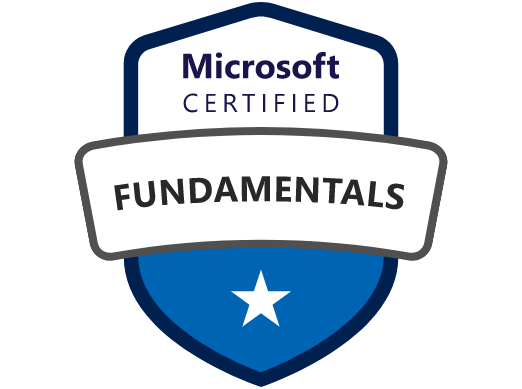
PL-900: Microsoft Power Platform Fundamentals
Prepare to pass the PL-900: Microsoft Power Platform Fundamentals Certification Exam

Course Description
Whether you’re a beginning technical professional, student, or business user, this certification will prove your knowledge in the business value and product capabilities of Microsoft Power Platform. Create simple Power Apps, connect data with Microsoft Dataverse, build a Power BI Dashboard, automate a process with Power Automate, or build a chatbot with Power Virtual Agents.
Audience Profile
Demonstrate knowledge in building solutions with Microsoft Power Platform.
Show familiarity in automating basic business processes with Power Automate and in creating simple Power Apps experiences.
Highlight familiarity in performing data analysis with Power BI and in building practical chatbots with Power Virtual Agents.
It is recommended to have familiarity with computer technology, data analytics, cloud computing, and the internet. This fundamentals certification can serve as a steppingstone for anyone interested in advancing to other certifications.
What Will You Learn?
Describe the business value of Microsoft Power Platform (20-25%)
Describe the business value of Microsoft Power Platform services
• gain insights into data by using Power BI
• build applications quickly by using Power Apps
• automate processes by using Power Automate
• use connectors to access services and data
• create powerful chatbots by using the Power Virtual Agents web app and Power Virtual Agents in Microsoft Teams
Describe the business value of extending business solutions by using Microsoft Power
Platform
• describe how Microsoft Power Platform apps work together with Dynamics 365 apps
• describe how Microsoft Power Platform business solutions can be used by Microsoft 365 apps and services
• describe how to use Microsoft Power Platform solutions with Microsoft Teams
• describe how Microsoft Power Platform business solutions can consume Microsoft Azure services including Azure Cognitive Services
• describe how Microsoft Power Platform business solutions can consume third-party apps and services
• describe use cases for AppSource
• describe how Microsoft Power Platform apps work together
Describe Microsoft Power Platform administration and security
• describe how Microsoft Power Platform implements security including awareness of Microsoft Dataverse security roles, Azure Identity Services, and Access Management (IAM)
• describe how to manage apps and users
• describe environments
• describe where to perform specific administrative tasks including Microsoft Power Platform Admin center and Microsoft 365 admin center
• describe data policies
• describe how Microsoft Power Platform supports privacy and accessibility guidelines
• describe Microsoft Power Platform privacy and accessibility capabilities
• describe Microsoft Power Platform governance capabilities
Identify the core components of Microsoft Power Platform (10-15%)
Describe Microsoft Dataverse
• describe the difference between databases and Dataverse
• describe the differences between Dataverse and Dataverse for Teams
• describe tables, columns, and relationships
• describe how to use common standard tables to describe people, places, and things
Describe Connectors
• describe triggers including trigger types and where triggers are used
• describe actions
• describe licensing options for connectors including standard or premium tier Identify use cases for custom connectors
Describe AI Builder
• identify the business value of AI Builder
• describe models including business card reader, detection model, form processing
model, and prediction model
• describe how the Power Apps and Power Automate can consume AI Builder data
Demonstrate the capabilities of Power BI (20-25%)
Identify common Power BI components
• identify and describe uses for visualization controls including pie, bar, donut, and scatter plots and KPIs
• describe the Power BI Desktop Reports, Data, and Model tabs
• compare and contrast Power BI Desktop and Power BI Service
• compare and contrast dashboards, workspaces, and reports
• describe the Power BI security model
Connect to and consume data
• connect to and combine data from multiple sources including Microsoft Excel
• describe how to use Power Query to clean and transform data
• describe and implement aggregate functions
• identify available types of data sources including Microsoft Excel
• describe use cases for shared datasets
• describe use cases for template apps
• describe options for viewing Power BI reports and dashboards
Build a basic dashboard using Power BI
• create a Power BI report
• create a Power BI dashboard
• publish and share reports and dashboards
Demonstrate the capabilities of Power Apps (25-30%)
Identify common Power Apps components
• describe the differences between canvas apps and model-driven apps
• describe use cases for formulas
Build a basic canvas app
• describe types of data sources
• connect to data by using connectors
• create an app from data
• use controls to design the user experience
• publish and share an app
Build a basic model-driven app
• create a model-driven app from tables
• modify forms
• create and modify views
• publish and share an app
Demonstrate the capabilities of Power Automate (10-15%)
Identify common Power Automate components
• identify flow types including cloud, desktop, and business process flows
• describe use cases for flows and available flow templates
• describe how Power Automate uses connector triggers and actions
• describe loops and conditions including switch, do until, and apply to each
• describe expressions
• describe use cases for approvals
• describe the Power Automate apps, including Power Automate Desktop, Power Automate mobile, and Power Automate portal
Build a basic cloud flow
• create a flow by using an instant, automated, or scheduled flow template
• modify a cloud flow
• use flow controls to perform data operations
• run a cloud flow
Demonstrate the capabilities of Power Virtual Agents (5-10%)
Describe the capabilities of Power Virtual Agents in Microsoft Teams
• describe use cases for Power Virtual Agents within Microsoft Teams
• describe topics, entities and actions
• describe message nodes, question nodes, conditions, trigger phrases, and the authoring canvas
Build and publish a basic chatbot
• create a chatbot
• create a topic
• call an action
• launch a Power Automate flow from a chatbot
Duration
1 Day